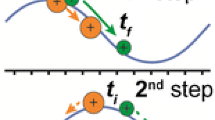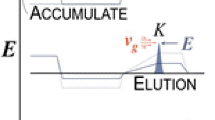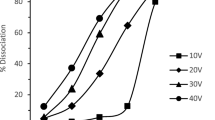Abstract
The influence of three different drift gases (helium, nitrogen, and argon) on the separation mechanism in traveling wave ion mobility spectrometry is explored through ion trajectory simulations which include considerations for ion diffusion based on kinetic theory and the electrodynamic traveling wave potential. The model developed for this work is an accurate depiction of a second-generation commercial traveling wave instrument. Three ion systems (cocaine, MDMA, and amphetamine) whose reduced mobility values have previously been measured in different drift gases are represented in the simulation model. The simulation results presented here provide a fundamental understanding of the separation mechanism in traveling wave, which is characterized by three regions of ion motion: (1) ions surfing on a single wave, (2) ions exhibiting intermittent roll-over onto subsequent waves, and (3) ions experiencing a steady state roll-over which repeats every few wave cycles. These regions of ion motion are accessed through changes in the gas pressure, wave amplitude, and wave velocity. Resolving power values extracted from simulated arrival times suggest that momentum transfer in helium gas is generally insufficient to access regions (2) and (3) where ion mobility separations occur. Ion mobility separations by traveling wave are predicted to be effectual for both nitrogen and argon, with slightly lower resolving power values observed for argon as a result of band-broadening due to collisional scattering. For the simulation conditions studied here, the resolving power in traveling wave plateaus between regions (2) and (3), with further increases in wave velocity contributing only minor improvements in separations.







Similar content being viewed by others
References
Dwivedi P, Wu C, Matz L, Clowers BH, Siems WF, Hill HH Jr (2006) Gas-phase chiral separations by ion mobility spectrometry. Anal Chem 78(24):8200–8206
Giles K, Pringle SD, Worthington KR, Little D, Wildgoose JL, Bateman RH (2004) Applications of a traveling wave-based radio-frequency-only stacked ring ion guide. Rapid Commun Mass Spectrom 18(20):2401–2414
Giles K, Wildgoose JL, Langridge DJ, Campuzano I (2010) A method for direct measurement of ion mobilities using a travelling wave ion guide. Int J Mass Spectrom 298(1–3):10–16
Giles K, Williams JP, Campuzano I (2011) Enhancements in travelling wave ion mobility resolution. Rapid Commun Mass Spectrom 25(11):1559–1566
Howdle MD, Eckers C, Laures AMF, Creaser CS (2010) The effect of drift gas on the separation of active pharmaceutical ingredients and impurities by ion mobility–mass spectrometry. Int J Mass Spectrom 298(1–3):72–77
Knapman TW, Berryman JT, Campuzano I, Harris SA, Ashcroft AE (2010) Considerations in experimental and theoretical collision cross-section measurements of small molecules using travelling wave ion mobility spectrometry-mass spectrometry. Int J Mass Spectrom 298(1–3):17–23
Manura DJ (2012) SIMION 8.1.1.14 incorporating the “Collision Model HS1” user program. LUA edn. Scientific Instrument Services, Inc., Ringoes, NJ
Mason EA, Schamp HW (1958) Mobility of gaseous ions in weak electric fields. Ann Phys 4(3):233–270
Matz L, Hill H, Beegle L, Kanik I (2002) Investigation of drift gas selectivity in high resolution ion mobility spectrometry with mass spectrometry detection. J Am Soc Mass Spectrom 13(4):300–307
Pringle SD, Giles K, Wildgoose JL, Williams JP, Slade SE, Thalassinos K, Bateman RH, Bowers MT, Scrivens JH (2007) An investigation of the mobility separation of some peptide and protein ions using a new hybrid quadrupole/travelling wave IMS/oa-ToF instrument. Int J Mass Spectrom 261(1):1–12
Reid Asbury G, Hill HH Jr (2000) Using different drift gases to change separation factors in ion mobility spectrometry. Anal Chem 72(3):580–584
Ruotolo BT, McLean JA, Gillig KJ, Russell DH (2004) Peak capacity of ion mobility mass spectrometry: the utility of varying drift gas polarizability for the separation of tryptic peptides. J Mass Spectrom 39(4):361–367
Rusyniak M, Ibrahim Y, Alsharaeh E, Meot-Ner M, El-Shall MS (2003) Mass-selected ion mobility studies of the isomerization of the benzene radical cation and binding energy of the benzene dimer cation. Separation of isomeric ions by Dimer Formation. J Phys Chem A 107(38):7656–7666
Shvartsburg AA, Smith RD (2008) Fundamentals of traveling wave ion mobility spectrometry. Anal Chem 80(24):9689–9699
Zhong Y, Hyung S-J, Ruotolo BT (2011) Characterizing the resolution and accuracy of a second-generation traveling-wave ion mobility separator for biomolecular ions. Analyst 136(17):3534–3541
Acknowledgements
JCM acknowledges David Manura (Scientific Instrument Services, Inc.) for insightful direction in developing the simulation model. JAM acknowledges initial discussions with Alex Shvartsburg (Pacific Northwest National Laboratory) on the separation mechanisms in traveling wave. Financial support for this work was provided by the National Institutes of Health (NIDA RC2DA028981), the Defense Threat Reduction Agency (HDTRAI-09-1-001), the National Science Foundation (MRI CHE-1229341), the Vanderbilt Institute of Chemical Biology, the Vanderbilt Institute for Integrative Biosystems Research and Education, and the Vanderbilt University College of Arts and Sciences.
Author information
Authors and Affiliations
Corresponding author
Rights and permissions
About this article
Cite this article
May, J.C., McLean, J.A. The influence of drift gas composition on the separation mechanism in traveling wave ion mobility spectrometry: insight from electrodynamic simulations. Int. J. Ion Mobil. Spec. 16, 85–94 (2013). https://doi.org/10.1007/s12127-013-0123-7
Received:
Revised:
Accepted:
Published:
Issue Date:
DOI: https://doi.org/10.1007/s12127-013-0123-7




